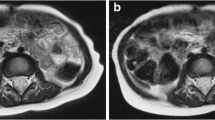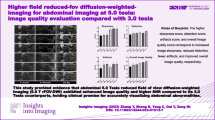Abstract
Background
Single-shot fast spin echo (SSFSE) is particularly appealing in pediatric patients because of its motion robustness. However radiofrequency energy deposition at 3 tesla forces long pauses between slices, leading to longer scans, longer breath-holds and more between-slice motion.
Objective
We sought to learn whether modulation of the SSFSE refocusing flip-angle train could reduce radiofrequency energy deposition without degrading image quality, thereby reducing inter-slice pauses and overall scan times.
Materials and methods
We modulated the refocusing flip-angle train for SSFSE to minimize energy deposition while minimizing blurring and motion-related signal loss. In a cohort of 50 consecutive patients (25 boys, mean age 5.5 years, range 1 month to 17 years) referred for abdominal MRI we obtained standard SSFSE and variable refocusing flip-angle (vrfSSFSE) images and recorded sequence scan times. Two readers independently scored the images in blinded, randomized order for noise, tissue contrast, sharpness, artifacts and left lobe hepatic signal uniformity on a four-point scale. The null hypothesis of no difference between SSFSE and vrfSSFSE image-quality was assessed with a Mann–Whitney U test, and the null hypothesis of no scan time difference was assessed with the paired t-test.
Results
SSFSE and vrfSSFSE mean acquisition times were 54.3 and 26.2 s, respectively (P-value <0.0001). For each reader, SSFSE and vrfSSFSE noise, tissue contrast, sharpness and artifacts were not significantly different (P-values 0.18–0.86). However, SSFSE had better left lobe hepatic signal uniformity (P < 0.01, both readers).
Conclusion
vrfSSFSE is twice as fast as SSFSE, with equivalent image quality with the exception of left hepatic lobe signal heterogeneity.







Similar content being viewed by others
References
Brenner DJ (2002) Estimating cancer risks from pediatric CT: going from the qualitative to the quantitative. Pediatr Radiol 32:228–231, discussion 228–231
Olsen OE (2008) Imaging of abdominal tumours: CT or MRI? Pediatr Radiol 38:S452–S458
Semelka RC, Kelekis NL, Thomasson D et al (1996) Abdominal MR imaging using the HASTE sequence. Proceedings of the Society of Magnetic Resonance, New York, p 219
Hennig J, Weigel M, Scheffler K (2003) Multiecho sequences with variable refocusing flip angles: optimization of signal behavior using smooth transitions between pseudo steady states (TRAPS). Magn Reson Med 49:527–535
Busse RF (2004) Reduced RF power without blurring: correcting for modulation of refocusing flip angle in FSE sequences. Magn Reson Med 51:1031–1037
Busse RF, Brau AC, Vu A et al (2008) Effects of refocusing flip angle modulation and view ordering in 3D fast spin echo. Magn Reson Med 60:640–649
Loening A, Saranathan M, Ruangwattanapaisarn N et al (2014) Flip angle modulation in single shot fast spin echo imaging greatly increases speed with little change in diagnostic image quality. Proceedings of the Joint Annual Meeting ISMRM-ESMRMB, Milan, p 2174
Saranathan M, Loening AM, Litwiller DV et al (2014) Optimized refocusing flip angles for efficient single-shot fast spin echo imaging. Proceedings of the Joint Annual Meeting ISMRM-ESMRMB, Milan, p 2175
(2014) Criteria for Significant risk investigations of magnetic resonance diagnostic devices. U.S. Food and Drug Administration, Silver Spring, MD : http://www.fda.gov/downloads/MedicalDevices/DeviceRegulationandGuidance/GuidanceDocuments/ucm072688.pdf
Hennig J, Scheffler K (2001) Hyperechoes. Magn Reson Med 46:6–12
Madhuranthakam AJ, Busse RF, Brittain JH et al (2007) Sensitivity of low flip angle SSFSE of the abdomen to cardiac motion. Proceedings of the ISMRM, Berlin, p 15
Madhuranthakam AJ, Yu H, Shimakawa A et al (2010) T(2)-weighted 3D fast spin echo imaging with water-fat separation in a single acquisition. J Magn Reson Imaging 32:745–751
Reeder SB, Wintersperger BJ, Dietrich O et al (2005) Practical approaches to the evaluation of signal-to-noise ratio performance with parallel imaging: application with cardiac imaging and a 32-channel cardiac coil. Magn Reson Med 54:748–754
Seifert F, Wubbeler G, Junge S et al (2007) Patient safety concept for multichannel transmit coils. J Magn Reson Imaging 26:1315–1321
Acknowledgments
Support of NIH R01 EB009690, NIH P41 EB015891, and the Tashia and John Morgridge Faculty Scholars Fund.
Conflicts of interest
D.V. Litwiller is an employee of GE Healthcare.
Author information
Authors and Affiliations
Corresponding author
Rights and permissions
About this article
Cite this article
Ruangwattanapaisarn, N., Loening, A.M., Saranathan, M. et al. Faster pediatric 3-T abdominal magnetic resonance imaging: comparison between conventional and variable refocusing flip-angle single-shot fast spin-echo sequences. Pediatr Radiol 45, 847–854 (2015). https://doi.org/10.1007/s00247-014-3227-2
Received:
Revised:
Accepted:
Published:
Issue Date:
DOI: https://doi.org/10.1007/s00247-014-3227-2




